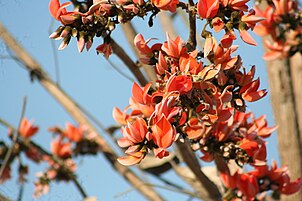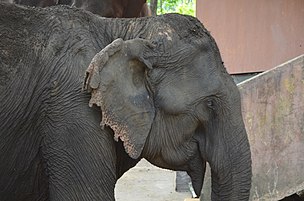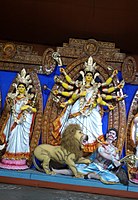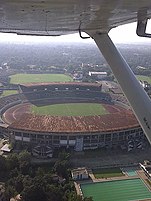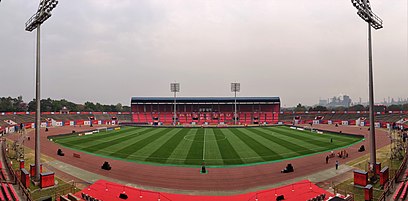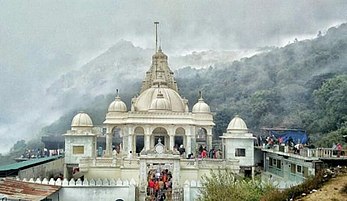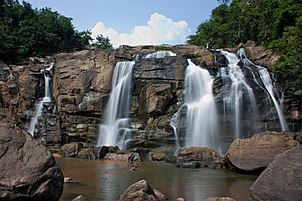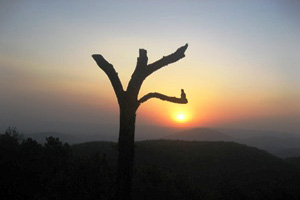Jharkhand
Jharkhand | ||
|---|---|---|
IIT ISM, Panchet Dam at Damodar river, Samet Shikharji Jain Mahatirth, Baidyanath Temple, Patratu Highway and Dalma Wildlife Sanctuary | ||
| Etymology: "Forest Land" | ||
| Nickname: "Land of Forests" | ||
| Motto(s): Satyameva Jayate (Truth alone triumphs) | ||
Formation | 15 November 2000 | |
State Legislature | Unicameral | |
| • Assembly | Jharkhand Legislative Assembly (81 seats) | |
| National Parliament | Parliament of India | |
| • Rajya Sabha | 6 seats | |
| • Lok Sabha | 14 seats | |
| High Court | Jharkhand High Court | |
| Area | ||
| • Total | 79,716 km2 (30,779 sq mi) | |
| • Rank | ||
| GDP | ||
| • Total (2024–25) | ||
| • Rank | 19th | |
| • Per capita | ||
| Time zone | UTC+05:30 (IST) | |
| ISO 3166 code | IN-JH | |
| Vehicle registration | JH | |
| HDI (2022) | ||
| Literacy (2011) | ||
| Sex ratio (2021) | 948♀/1000 ♂[6] (26th) | |
| Website | jharkhand | |
| Symbols of Jharkhand | ||
 | ||
| Bird | Koel | |
| Flower | Palash | |
| Mammal | Indian elephant[7] | |
| Tree | Sal | |
| State highway mark | ||
 | ||
| State highway of Jharkhand JH SH1 - JH SH | ||
| List of Indian state symbols | ||
Jharkhand (
Jharkhand suffers from what is sometimes termed a
Etymology
The word "Jhar" means 'forest' and "Khand" means 'land' in various Indo-Aryan languages. Thus "Jharkhand" means forest land.[16]
In the ancient period, in the
History
Ancient period
The region has been inhabited since the Mesolithic-Chalcolithic period, as shown by several ancient cave paintings.[20][21][22] Stone tools have been discovered from Chota Nagpur Plateau region which are from the
In the Mahabharata, the region was referred as Kark Khand due to its location near Tropic of Cancer.
Medieval period
In the 7th century, the Chinese traveller Xuanzang passed through the region. He described the kingdom as Karnasuvarna, with Shashanka as its ruler. To the north of Karn-Suberna was Magadha, Champa was in the east, Mahendra in the west, and Orissa in the south.[29]
During the medieval period, the region was governed by

Modern period
King
-
Jagannath temple at Ranchi built by king Ani Nath Shahdeo
-
Palamu Forts
During the 18th century, regions under the Kings of the Chero dynasty, Nagvanshi dynasty,
Subjugation, colonisation and imposition of taxes by the British East India Company resulted in spontaneous resistance from the local people. Chuar Rebellion, the first revolt against the British East India Company led by Jagannath Singh Patar in 1767 with the Bhumij tribals. The Bhumijes again revolted in 1769–71, led by their Sardar Ghatwals in Dhalbhum. In 1769, Raghunath Mahato also revolted against the British East India Company (EIC).[42]
In 1771, the revolt against the landlords and the British government was led by
The Hos in Singhbhum revolted in 1820 and a Kol revolt occurred in 1832. Also in 1832 the Bhumijs revolted again against the British, this time under the leadership of Ganga Narayan Singh, known as the Bhumij Rebellion. During the 19th century, large numbers of santals from Manbhum, Hazaribagh, Midnapore were settled by British in Damin-i-koh to cultivate the land and generate revenue. But the Santal revolted against tax imposition. The Santhal rebellion broke out in 1855 under the leadership of two brothers Sidhu and Kanhu. Later the British renamed it as Santal Pargana.[44]
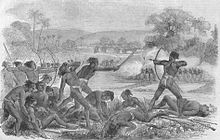
After the
In October 1905, the exercise of British influence over the predominantly
In 1936, all nine states were transferred to the Eastern States Agency, the officials of which came under the direct authority of the Governor-General of India, rather than under that of any provinces.
In March 1940, the INC 53rd Session
At that time, under the leadership of Netajee Subhas Chandra Bose a conference against Samjhauta was also completed. In Ramgarh, Subhas Chandra Bose was seen as president of the All India Forward Block and M. N. Roy was seen as leader of the Radical democratic party.

Post Independence
After Indian independence in 1947, the rulers of many states chose to accede to the
Later the

In July 1988, the
The central government formed a committee on the Jharkhand matter in 1989. It stressed the need for greater allocation of development funds for the area. There was a provision for limited internal autonomy in the hill area of
In 1998, when the separate state movement was falling apart, Justice
In 1999 the Bharatiya Janata party promised to form a separate Vanachal state if they won the state election with a majority of votes.
Jharkhand statehood
The dynamics of resources and the politics of development still influence the socio-economic structures in Jharkhand, which was carved out of the relatively underdeveloped southern part of
Naxal insurgency
Jharkhand has been at the centre of the
Despite having a presence in almost 7.80% of India's geographical area
On 5 March 2007,
Geography
Jharkhand is located in the eastern part of India and is enclosed by West Bengal to the eastern side, Chhattisgarh and Uttar Pradesh to the western side, Bihar to the northern part and Odisha to the southern part.
Jharkhand envelops a geographical area of 79,716 square kilometres (30,779 sq mi). Much of Jharkhand lies on the Chota Nagpur Plateau. Many rivers pass through the Chota Nagpur plateau. They are: Damodar, North Koel, Barakar, South Koel, Sankh and Subarnarekha rivers. The higher watersheds of these rivers stretch out within the Jharkhand state. Much of the Jharkhand state is still enclosed by forest. Forests sustain the population of elephants and tigers.
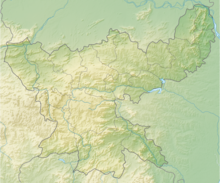
Climate
Climate of Jharkhand varies from
Hills and mountain ranges
- Jainsand locals. It is believed in the Jain culture that 20 of the 24 Tirthankaras attained Moksha from this place. The height of the hill is 1,365 meters.
- Netarhat: Netarhat is a town in Latehar district. Referred to as the "Queen of Chotanagpur", it is a hill station. Netarhat Residential School is located here. Netarhat Dam is also located in this area.
- Sahibganj and Godda districts of Eastern part of Jharkhand. The Rajmahal hillsbelong to the Jurassic era. These hills like others also have many waterfalls, lakes and greenery.
- Trikut: Trikut Hill is located ten kilometres away from Deoghar and lies on the way to Dumka in Jharkhand. Trikut hill is also called Trikutchal because there are 3 major peaks on the hill. The height of Trikut hill is 2470 feet.
- Tagore Hill: The Tagore Hill is also recognised as the Morabadi Hill. The Tagore hill is located in Morabadi, Ranchi. The brother of Rabindranath Tagore, Jyotirindranath Tagore had made a tour at Ranchi in the year 1908.[75]
Main Rivers
- holy riverGanga passes through the north-eastern district of Sahebganj. Cities on the banks of Ganga river in Jharkhand: Sahebganj, Rajmahal
- Son River: Origin of Son River: Amarkantak, Cities on the Shore of Son River: Sidhi
- Subarnarekha River: Origin of Subarnarekha River: (Nagdi Ranchi) Chota Nagpur Plateau, Cities on the Shore of Subarnarekha River: Ranchi, Chandil, Jamshedpur, Ghatshila, Gopiballavpur
- Kharkai River: Origin of Kharkai River: Mayurbhanj District, Odisha; Cities on the Shore of Kharkai River: Rairangpur, Adityapur, and enters the Subarnarekha river in north-western Jamshedpur.
- Damodar River: Origin of Damodar River: Chota Nagpur Plateau (Tori latehar), Cities on the Shore of Damodar River: latehar, lohardaga, Ramgarh, Gridih, Dhanbad, Bokaro, Asansol, Raniganj, Durgapur, Bardhaman
- North Koel River: Origin of North Koel River: Chota Nagpur plateau, Cities on Shore of North Koel River: Daltonganj
- South Koel River: Origin of South Koyal River: Chota Nagpur Plateau (Nagdi Ranchi), Cities on the Shore of South Koyal River: Manoharpur, Rourkela
- Lilajan River: Also known as Falgu river. Origin of Lilajan River: Northern Chota Nagpur Plateau, City on the Shore: Gaya
- Ajay River: Origin of Ajay River: Munger, Cities on the Shore of Ajay River: Purulia, Chittaranjan, Ilambazar, Jaydev Kenduli
- Mayurakshi River: Origin of Mayurakshi River: Trikut hill, City on the Shore of Mayurakshi River: Suri
- Barakar River: Origin: Padma in Hazaribagh, Barakar Nadi flows through the districts of Koderma, Giridih, Hazaribagh, etc.
For the list of dams built across these revere refer to [2]
Flora and Fauna
Jharkhand has a rich variety of
Part of the reason for the variety and diversity of
-
Palashflowers, bright red, pepper the skyline in Jharkhand during fall, also known as forest fire
-
A crocodile at Muta crocodile breeding centre at Ormanjhi, Ranchi
-
A FemaleIndian Elephant at Dalma Wildlife Sanctuaryin Jharkhand
Demographics
| Year | Pop. | ±% |
|---|---|---|
| 1901 | 6,068,233 | — |
| 1911 | 6,747,122 | +11.2% |
| 1921 | 6,767,770 | +0.3% |
| 1931 | 7,908,737 | +16.9% |
| 1941 | 8,868,069 | +12.1% |
| 1951 | 9,697,254 | +9.4% |
| 1961 | 11,606,489 | +19.7% |
| 1971 | 14,227,133 | +22.6% |
| 1981 | 17,612,069 | +23.8% |
| 1991 | 21,844,911 | +24.0% |
| 2001 | 26,945,829 | +23.4% |
| 2011 | 32,988,134 | +22.4% |
| Source: Census of India[77] | ||
According to the
Languages
Jharkhand is linguistically diverse, with speakers of Indo-Aryan, Dravidian, and Austroasiatic languages. Among those,

Religion
As per the
Hindus form majority in 19 out of 24 districts of the Jharkhand.
Government and administration
The constitutional head of the government of Jharkhand is the governor, who is appointed by the President of India. The real executive power rests with the chief minister and the cabinet. The political party or the coalition of political parties having a majority in the Legislative Assembly forms the government.
The head of the bureaucracy of the state is the chief secretary. Under this position, is a hierarchy of officials drawn from the Indian Administrative Service, Indian Police Service, Indian Forest Service and different wings of the state civil services. The judiciary is headed by the Chief Justice. Jharkhand has a High Court which has been functioning since 2000. All the branches of the government are located in the state capital, Ranchi.
Administrative districts
The state was formed with 18 districts that were formerly part of south Bihar. Some of these districts were reorganised to form 6 new districts, namely, Latehar, Saraikela Kharsawan, Jamtara, Pakur, Khunti and Ramgarh. At present, the state has 5 Divisions and 24 Districts. One interesting thing about Jharkhand is that all its districts, except Lohardaga and Khunti, share a border with a neighbouring state.[88]
Divisions and districts
Major cities
Largest Cities in Jharkhand
(2011 Census of India estimate)[89]
| Rank | City | District | Population | Rank | City | District | Population |
  |
|---|---|---|---|---|---|---|---|---|
| 01 | Jamshedpur | East Singbhum | 1,339,438 | 06 | Phusro | Bokaro | 186,139 | |
| 02 | Dhanbad | Dhanbad | 1,196,214 | 07 | Hazaribagh | Hazaribagh | 153,595 | |
| 03 | Ranchi | Ranchi | 1,126,741 | 08 | Giridih | Giridih | 143,630 | |
| 04 | Bokaro Steel City | Bokaro | 564,319 | 09 | Ramgarh | Ramgarh | 132,441 | |
| 05 | Deoghar | Deoghar | 203,123 | 10 | Medininagar | Palamu | 120,325 |
Economy
The gross domestic product of Jharkhand is estimated at ₹3.83 lakh crore (US$48 billion) in 2020–21. The per capita GDP of Jharkhand in 2018-19 was ₹82,430 (US$1,000).[90]

Jharkhand has several towns and innumerable villages with civic amenities. Urbanization ratio is 24.1%.
In February 2006, the government of Jharkhand established the Jharkhand Silk Textile and Handicraft Development Corporation (Jharcraft) which promotes local sericulture and weaving and the wider marketing of these products.[94][95]
Agriculture is another major economic sector. Farmers in Jharkhand produce several crops such as rice, wheat, maize, pulses, potatoes, and vegetables such as tomato, carrots, cabbage, brinjal, pumpkin, and papaya. Other important industries include the cottage industry and IT.[96]
Culture
Cuisine

Staple foods of Jharkhand are rice, dal, vegetables, and tubers. Spices are sparingly used in cuisine. Famous dishes include Chhilka Roti, Malpua, Pitha, Dhooska, Arsa roti, Dudhauri, and Panipuri (Gupchup).[97][98] Rugra and Putoo is a type of edible mushroom that is grown extensively in Jharkhand and harvested during the rainy months. It has a hardened, white, edible shell and a softer dark coloured centre. Bamboo shoot are a versatile ingredient used in many culinary traditions, particularly in Jharkhand cuisine. They can be boiled, steamed, stir-fried, or pickled, making them a popular addition to dishes such as soups, curries, and salads. Bamboo shoots are known for their ability to absorb the flavours of the ingredients they are cooked with, enhancing the overall taste of the dishes.[99] The leaves of Munga (Moringa oleifera) and Koinar (Bauhinia variegata) trees are used as a leafy vegetable or Saag.[100]
Local alcoholic drinks include rice beer, originally known as Handi or Handia, named after the vessel, handi (earthen pot), used to make it. Handia is culturally associated with natives, i.e., Sadans and Tribals; this drink is consumed by both men and women on social occasions like marriage and festivals.[101][102] Another common liquor is called Mahua daru, made from flowers of the Mahua tree (Madhuca longifolia).[103]
Folk music and dance

There are several folk dances in Jharkhand such as:
Festivals
Major local festivals of Jharkhand are
-
Karam festivalin Jharkhand
-
Durga Puja in Jharkhand
Paintings

Sohrai and Khovar painting is a mural art form practised by women. Sohrai painting is traditionally done at the Sohrai harvest festival, while Khovar painting is done at weddings.[105]
Tattoo
The tattoo making tradition of Godna is an essential part of local tradition.[105]
Cinema
Jharkhand produces many films in regional and Tribal languages including Nagpuri, Khortha, Santali, Ho, and Kurukh.[106] The film industry in the state of Jharkhand is known as Jhollywood.[107][108]
Media
There are some television channels, newspapers, and radio stations which operate in Jharkhand. DD Jharkhand is an important channel in Jharkhand. All India Radio operates from Ranchi.[109]
Transport
Air
Birsa Munda Airport is the largest domestic airport in the state with air connectivity to major Indian cities of Delhi, Kolkata, Bangalore, Mumbai, Hyderabad among others.[110]
Deoghar Airport is the second busiest airport located in the state of Jharkhand, India. It is the second operational airport in state of Jharkhand after Ranchi.[111]
Sonari Airport at Jamshedpur is the third operational airport in the state and it has daily flight to Bhubaneswar and Kolkata.
Bokaro Airport is currently under construction and once completed will be 4th operational airport of the state. It is being developed under UDAN scheme.
Other airports present in the state are
Roads
Jharkhand has extensive network of
Ports
Jharkhand is landlocked state but has numerous rivers and waterways.[116] A multi-modal port has been planned at Sahebganj where river Ganges flows.[117] The project is estimated to cost ₹65,000 million and phase-1 is estimated to be completed by 2019.[118]
Rail
Jharkhand is very well connected by railways. The state has numerous railway stations and railway junctions.[119] Hilly regions of state are equipped with tunnels that form essential organ of railways.
-
View from theSahibganjRailway Station
Education
As per the 2011 census conducted by Government of India the official literacy rate for the state was 66.41% (male: 76.84%; female: 55.42%) with nine districts above the average literacy rate:[120][121]
- Ranchi: 76.06% (male: 84.26%; female: 67.44%)
- East Singhbhum: 75.49% (male: 83.75%; female: 66.81%)
- Dhanbad: 74.52% (male: 83.81%; Female: 64.29%)
- Ramgarh: 73.17% (male: 82.44%; female: 63.09%)
- Bokaro: 72.01% (male: 82.51%; female: 60.63%)
- Hazaribagh: 69.75% (male: 80.01%; female: 58.95%)
- Simdega: 67.99% (male: 76.08%; female: 59.92%)
- Saraikela Khasawan: 67.70% (male: 79.03%; female: 55.88%)
- Lohardaga: 67.61% (male: 77.21%; female: 57.69%)
- Koderma: 66.84% (male: 79.78%; female: 53.23%)
Since the formation of the new state, the Jharkhand Education Project Council (JEPC) has been implementing four projects to spread elementary education: DPEP, SSA, NPEGEL, and KGBV. The state has been moving towards the goal of universal elementary education but the target of 100% enrolment and retention of children in schools has not yet been attained.[122] Jharkhand has made primary education so accessible that 95% of children of ages 6–11 are enrolled in school, as opposed to 56% in 1993–94; this will likely improve literacy a great deal.[citation needed]
Schools
The medium of instruction in schools is
The school system comprises various private and public schools. The government schools are abundant. Few notable schools are: St. Thomas School, Ranchi, Sainik School Tilaiya, Loyola School, Jamshedpur, Delhi Public School, Bokaro, Delhi Public School, Ranchi, Bishop Westcott Boys' School, Ramakrishna Mission Vidyapith, Deoghar, De Nobili School and St. Xavier's School, Hazaribagh.
In 2009 Franz Gastler established Yuwa School a NGO in Hutup village in Ranchi district with helps of friends to use football as a platform to combat child marriage, illiteracy and human trafficking in rural India.[123] In 2019, It won the Laureus Sport for Good Award.[124]
Universities and colleges
- AISECT University, Jharkhand, Hazaribagh
- Arka Jain University, Jamshedpur
- Binod Bihari Mahto Koyalanchal University, Dhanbad
- Birsa Agricultural University, Kanke, Ranchi
- Central University of Jharkhand, Brambe, Ranchi
- Jharkhand Rai University, Ranchi
- Jharkhand Raksha Shakti University, Ranchi
- Kolhan University, Chaibasa
- National University of Study and Research in Law, Ranchi
- Nilamber-Pitamber University, Medininagar
- Radha Govind University, Ramgarh
- Ranchi University, Ranchi
- Sarala Birla University, Ranchi
- Sido Kanhu Murmu University, Dumka
- Vinoba Bhave University, Hazaribagh
Autonomous
- Dr. Shyama Prasad Mukherjee University, formerly Ranchi college
- Indian Institute of Information Technology, Ranchi
- Indian Institute of Management Ranchi
- Indian Institute of Technology (Indian School of Mines), Dhanbad
- National Institute of Foundry and Forge Technology(NIFFT), Ranchi
- National University of Study and Research in Law
- National Institute of Technology, Jamshedpur
- St. Xavier's College, Ranchi
- Xavier Institute of Social Service (XISS), Ranchi
- Xavier Labour Relations Institute(XLRI), Jamshedpur
Agriculture
- Indian Institute of Agricultural Biotechnology, Ranchi
Engineering

- Birla Institute of Technology, Mesra, Ranchi
- Birsa Institute of Technology Sindri, Dhanbad
- DAV Institute of Engineering & Technology, Daltonganj
- Indian Institute of Technology (Indian School of Mines), Dhanbad, Dhanbad
- National Institute of Foundry and Forge Technology(NIFFT), Ranchi
- National Institute of Technology, Jamshedpur
Management
- Indian Institute of Management Ranchi IIM-Ranchi
- XLRI - Xavier School of Management, Jamshedpur
- NSIBM - Netaji Subhas Institute of Hotel & Business Management, Jamshedpur
Medical colleges
- All India Institute of Medical Sciences (AIIMS), Deoghar
- Hazaribag College of Dental Sciences and Hospital, Hazaribagh
- Mahatma Gandhi Memorial Medical College (MGM), Jamshedpur
- Medinirai Medical College and Hospital, Palamu
- Phulo Jhano Murmu Medical College and Hospital, Dumka
- Rajendra Institute of Medical Sciences (RIMS), Ranchi
- Shaheed Nirmal Mahto Medical College, Dhanbad, Dhanbad
- Shaheed Sheikh Bhikhari Medical College and Hospital, Hazaribagh
Psychiatry
- Central Institute of Psychiatry, Ranchi
Public Health
Because of its mild climate, Jharkhand, particularly its capital Ranchi, has been a health resort. As far back as 1918, facilities were set up for treatment of
European Mental Hospital was established along with Indian Mental Hospital. Today they are called Central Institute of Psychiatry and Ranchi Institute of Neuro-psychiatry and Allied Sciences respectively. In certain areas of Jharkhand, poverty and consequent malnutrition have given rise to diseases like tuberculosis (TB). In fact, TB has assumed epidemic proportions in certain areas of the state. For management and treatment of such TB, Itki TB Sanatorium, Ranchi, established in 1928 has been doing work as a premier institute for clinical and programmatic management of TB. The Itki TB Sanatorium is well equipped and accredited by the Indian government for quality assurance and Culture and Drug Sensitivity Testing for M.TB. It provides free of cost treatment for TB as well as drug-resistant TB. Likewise, in the field of treatment of cancer, Tata Main Hospital, Jamshedpur,[126] is rendering pioneering work. In the same way, Bokaro General Hospital equipped with modern facilities for the treatment of cancer and heart-related problems with the capacity of 1100 beds one of the largest in eastern India.
Although several public and private health facilities are available in the state, overall infrastructure for dispensing health related services require improvements. An exception is the Tata Motors Hospital which is an example of an ISO 14001 and 18001 certified hospital with DNB teaching facilities.[citation needed]
Ranchi, the capital, has witnessed a sharp growth in the number of hospitals.
Almost 80% of Jharkhand's people are farmers, although it contains 40% of India's mineral reserves it has some of India's poorest people, in Summer 2009 the state was threatened by drought, with people criticising the government for not providing food aid or assistance.[132]
Sports
JRD TATA Sports Complex, Jamshedpur hosts football matches of Indian Super League and is the home of ISL based football club Jamshedpur FC.
Other notable cricketers from Jharkhand are Varun Aaron, Shahbaz Nadeem, and Saurabh Tiwary. He was one of the key batsmen in the Indian team that won the 2008 U/19 Cricket World Cup in Malaysia. Other sportspeople include Deepika Kumari, a young archer who won gold medal in the 2010 Commonwealth games in the women's individual recurve event. Nikki Pradhan currently a member of the national hockey team. Pradhan was the first female hockey player from Jharkhand to represent India in the Olympics.
An
-
Aerial view of Keenan Stadium in Jamshedpur
-
JRD Tata Sports Complex
Tourism
Jharkhand is known for its waterfalls, hills and holy places.
Tattapani Hot Water Spring is located 8 km from Latehar. The hot spring water come out from different places on the Sukari River bed. Reach in sulphur, the hot spring is believed to have medicinal properties and good for skin.[140]
There are several attractions and wildlife sanctuaries in Jharkhand including Betla National Park and Dalma Wildlife Sanctuary, which are major attraction for tourists.[151][152][153][154]
State Museum Hotwar and Tribal Research Institute and Museum showcase various cultural heritage and tribal culture of Jharkhand.[155][156]
-
The ancient Baidyanath Jyotirlinga Temple in Deoghar
-
Jain temple at Samet Shikharji, the place from where twentyTirthankarsattained nirvana
See also
References
Footnotes
- ^ Other languages clubbed within the Hindi group of languages by the Indian census
- Scheduled Tribes include Bidin (29,187), Adi (9,135), Gond (2,419) and Birsa (2,392). The remaining "Other unclassified religions" are Munda, Ho, Oraon, Achinthar, Kharwar, Paharia, Sarvdharm, Krupa, Dupub, Malla, Tana Bhagat, Marangboro, Saranath, Kuir, Loco Bohra, and Nature worship practised by various tribes. In summary, Sarna ranks as the third-largest religion with 12.4997%, while Addi Bassi, Bidin, Adi, Gond and Birsa hold the sixth, seventh, tenth, eleventh and twelfth positions, respectively, with percentages of 0.1286%, 0.0885%, 0.0277%, 0.0073% and 0.0073% of the state's population.[83]
Sources
- ^ "Important Tourist attraction of Giridih". 18 October 2005. Archived from the original on 18 October 2005. Retrieved 24 March 2023.
- ^ "Jharkhand Profile 2011 Census" (PDF). Registrar General & Census Commissioner, India. Archived (PDF) from the original on 22 April 2016. Retrieved 13 February 2017.
- ^ a b c d "Report of the Commissioner for linguistic minorities: 52nd report (July 2014 to June 2015)" (PDF). Commissioner for Linguistic Minorities, Ministry of Minority Affairs, Government of India. pp. 43–44. Archived from the original (PDF) on 15 November 2016. Retrieved 16 February 2016.
- ^ a b "Jharkhand gives second language status to Magahi, Angika, Bhojpuri and Maithili". The Avenue Mail. 21 March 2018. Archived from the original on 28 March 2019. Retrieved 30 April 2019.
- ^ "Jharkhand notifies Bhumij as second state language". The Avenue Mail. 5 January 2019. Archived from the original on 23 April 2022. Retrieved 17 April 2022.
- ^ "Sex ratio of State and Union Territories of India as per National Health survey (2019-2021)". Ministry of Health and Family Welfare, India. Archived from the original on 8 January 2023. Retrieved 8 January 2023.
- ^ "State animals, birds, trees and flowers" (PDF). Wildlife Institute of India. Archived from the original (PDF) on 4 March 2009. Retrieved 5 March 2012.
- ^ "Jharkhand". Merriam-Webster.com Dictionary.
- ^ "Jharkhand – At a Glance". Archived from the original on 5 May 2012. Retrieved 9 May 2012.
- ^ a b "Adventure capital of the east, Jharkhand will drive you crazy". nyoooz.com. Archived from the original on 3 April 2019. Retrieved 30 April 2019.
- ^ "Jharkhand registers 385% increase in foreign tourist visits". hindustantimes.com. Archived from the original on 3 April 2019. Retrieved 30 April 2019.
- ^ Jharkhand Profile (2011). "Census India" (PDF). censusindia.gov.in. Archived (PDF) from the original on 22 April 2016. Retrieved 20 March 2017.
- ^ "Resource Curse and Jharkhand" (PDF). Economic & Political Weekly. Archived (PDF) from the original on 13 December 2017. Retrieved 12 December 2017.
- Daily Bhaskar. 31 March 2014. Archivedfrom the original on 4 April 2019. Retrieved 30 April 2019.
- ^ "UNDP- Jharkhand: Economic and Human Development Indicators" (PDF). www.in.undp.org. Archived (PDF) from the original on 27 January 2018. Retrieved 20 March 2017.
- ISBN 0313316171. Retrieved 8 April 2022.
- ^ a b "Nagpuri Shist Sahitya". Retrieved 24 September 2022.
- ^ ISBN 978-81-8324-145-8. Archivedfrom the original on 4 October 2021. Retrieved 30 May 2020.
- ^ Ram Chandra Prasad (1983). Bihar. National Book Trust, India. p. 69. Retrieved 8 April 2022.
- ^ ISBN 9788123023458.
- ^ The Telegraph. 13 March 2008. Archived from the originalon 6 September 2018. Retrieved 30 April 2019.
- ^ ISBN 9788131711200. Archivedfrom the original on 25 December 2019. Retrieved 7 September 2018.
- from the original on 5 March 2021. Retrieved 17 March 2021 – via crossasia-repository.ub.uni-heidelberg.de.
- ^ "KABRA – KALA". www.asiranchi.org. Archived from the original on 8 October 2013. Retrieved 30 April 2019.
- ^ "Jharkhand's Historical References in the Mahabharata". riseranchi.in. 22 July 2023. Archived from the original on 3 November 2023. Retrieved 3 November 2023..
- ^ "Asura Site Saridkhel". asiranchicircle. Archived from the original on 14 May 2023. Retrieved 11 October 2022.
- ^ Lalit Aditya (October 2018). "Inscriptions in Jharkhand: A Preliminary Study". Retrieved 30 August 2022.
- ^ Sharma, Tej Ram (1978). Personal and Geographical Names in the Gupta Inscriptions. Concept Publishing Company. p. 258.
- ISBN 9789352669431. Archivedfrom the original on 4 October 2021. Retrieved 14 November 2020.
- ^ Roma Niyogi 1959, p. 119.
- ^ ISBN 9789352660001. Archivedfrom the original on 4 October 2021. Retrieved 29 July 2019.
- ^ Dey, Sanjoy (23 February 2021). "10th century Buddha Vihar discovered in Jharkhand's Hazaribag". Hindustan Times. Archived from the original on 9 April 2022. Retrieved 9 April 2022.
- ^ "Archaeologists uncover remains of ancient empire in Jharkhand". oneindia. 11 May 2009. Archived from the original on 12 January 2019. Retrieved 3 October 2022.
- ^ a b "History | Latehar, Government of Jharkhand". Archived from the original on 28 March 2019. Retrieved 30 April 2019.
- ^ "The Nagbanshis and the Cheros". archive.org. 1969.
- ^ "Navratangarh: Lost Kingdom of the Nagvanshis". livehistoryindia. 27 April 2019. Archived from the original on 28 September 2022. Retrieved 28 September 2022.
- ^ Lahiry 2014, p. 24.
- ^ "Palamufort". Archived from the original on 18 November 2015. Retrieved 20 December 2018.
- ^ "history". latehar.nic.in. Archived from the original on 28 March 2019. Retrieved 30 April 2019.
- ^ Hazaribagh District Gazetteer. The Bengal Secretariat Book Depot, Calcutta. 1905.
- ^ "Gazetteer - Chota Nagpur Tributary States Gazetteer. Statistics, 1901-02 - South Asia Archive". Archived from the original on 7 September 2018. Retrieved 30 April 2019.
- ^ "चुआड़ विद्रोह के महानायक, क्रांतिवीर शहीद रघुनाथ महतो की 277 वीं जयंती". Prabhat Khabar (in Hindi). 21 March 2015. Archived from the original on 29 November 2022. Retrieved 9 July 2023.
- ^ Yadav, Anumeha (12 April 2014). "A parallel conversation: Martyrs, rebels, and peasants". The Hindu. Archived from the original on 30 December 2018. Retrieved 30 April 2019.
- JSTOR 44147668.
- JSTOR 44143953.
- ^ "Raghubar pays tributes to Thakur Vishwnanth Sahdeo on his birth anniversary". Archived from the original on 7 November 2018. Retrieved 30 April 2019.
- ^ "JPCC remembers freedom fighters Tikait Umrao Singh, Sheikh Bhikari". news.webindia123.com. Archived from the original on 4 May 2019. Retrieved 4 May 2019.
- ^ Kaul, Chandrika. "From Empire to Independence: The British Raj in India 1858–1947". Archived from the original on 17 June 2016. Retrieved 22 November 2018.
- ^ "Historical Background, Latehar District, Jharkhand". Archived from the original on 13 October 2015. Retrieved 3 December 2018.
- ^ Birsa Munda and His Movement 1874–1901: A Study of a Millenarian Movement in Chotanagpur, by Kumar Suresh Singh. Oxford University Press, 1983
- Imperial Gazetteer of India, Volume 12. 1908–1931; Clarendon Press, Oxford
- ^ "All India Congress Committee - AICC". Archived from the original on 1 June 2013. Retrieved 3 December 2018.
- ^ Danik jagran Ranchi Page No.14, 2 October 2011
- ^ "Error". Archived from the original on 5 March 2016. Retrieved 30 April 2019.
- ^ "Photo Gallery of Mahatma Gandhi (1933-1948)". Archived from the original on 4 March 2016. Retrieved 30 April 2019.
- ^ "RAMGARH SESSION-1940". Archived from the original on 11 December 2017. Retrieved 30 April 2019.
- ^ "Chronology 1940". Archived from the original on 22 November 2018. Retrieved 30 April 2019.
- ^ Eastern States Agency. List of ruling chiefs & leading personages Delhi: Agent to Governor-General, Eastern States, 1936
- ^ ISBN 9788170226918. Archivedfrom the original on 3 November 2022. Retrieved 3 November 2022.
- ISBN 978-9355212368. Archivedfrom the original on 7 March 2023. Retrieved 5 November 2022.
- ISBN 978-9353886608. Archivedfrom the original on 3 November 2022. Retrieved 3 November 2022.
- ^ a b c "वनांचल की रूपरेखा, झारखंड का नाम". jagran. 17 August 2018. Archived from the original on 2 October 2022. Retrieved 2 October 2022.
- ^ "Tributes pour in for Justice Shahdeo". 10 January 2018. Archived from the original on 2 August 2020. Retrieved 14 November 2019.
- ^ "Remembering Justice LPN Shahdeo on his 7th death anniversary". 10 January 2019. Archived from the original on 2 August 2020. Retrieved 14 November 2019.
- ^ gigisoftsolutions. "History of Jharkhand, Jharkhand History". traveljharkhand.com. Archived from the original on 19 April 2015. Retrieved 20 July 2015.
- ^ "Uttaranchal, Vananchal and Chhattisgarh celebrate their statehood". indiatoday. 13 December 2012. Archived from the original on 2 October 2022. Retrieved 2 October 2022.
- ^ "About : Official Website of Government of Jharkhand". www.jharkhand.gov.in. Archived from the original on 23 November 2016. Retrieved 2 February 2017.
- ^ Bhaumik, Subir (5 February 2009). "Cell phones to fight India rebels". BBC News. Archived from the original on 8 February 2009. Retrieved 6 May 2010.
- ^ a b c "Rising Maoists Insurgency in India". Global Politician. 15 January 2007. Archived from the original on 11 April 2010. Retrieved 18 July 2010.
- ^ Maoists who menace India Archived 17 October 2015 at the Wayback Machine, New York Times, 17 April 2006
- ^ a b c "Hidden civil war drains India's energy". Asia Times Online. 9 August 2006. Archived from the original on 4 June 2011. Retrieved 18 July 2010.
{{cite web}}: CS1 maint: unfit URL (link) - ^ Thaker, Jayesh (12 April 2014). "Ex-MPs add she might to LS fight". The Telegraph. Kolkata. Archived from the original on 21 September 2017. Retrieved 30 April 2019.
- ^ "Climate: Jharkhand". Archived from the original on 15 October 2018. Retrieved 30 April 2019.
- ^ "Jharkhand: Climate". 16 July 2013. Archived from the original on 18 April 2019. Retrieved 30 April 2019.
- ^ "Tagore Hill". ranchi.nic.in. Archived from the original on 2 August 2020. Retrieved 24 July 2020.
- ^ "Birds and animals found in the forest of the Palamau district". Official website of the Palamau district. Archived from the original on 12 January 2009. Retrieved 5 April 2009.
- ^ "Census Population" (PDF). Census of India. Ministry of Finance India. Archived from the original (PDF) on 19 December 2008. Retrieved 18 December 2008.
- ^ a b c "Jharkhand Provisional Result-Census 2011-Data Sheet" (PDF). Office of the Registrar General & Census Commissioner, India. Ministry of Home Affairs, Government of India. Archived (PDF) from the original on 17 May 2017. Retrieved 13 July 2017.
- ^ "Table C-16 Population by Mother Tongue: Jharkhand". censusindia.gov.in. Registrar General and Census Commissioner of India. Archived from the original on 13 July 2023. Retrieved 30 April 2023.
- ^ "Bedlam & bill rush in Assembly". The Telegraph. 21 June 2018. Archived from the original on 23 July 2018. Retrieved 30 April 2019.
- ^ a b c "Table C-01 Population By Religion: Jharkhand". census.gov.in. Registrar General and Census Commissioner of India. Archived from the original on 9 May 2022. Retrieved 30 April 2023.
- ^ a b "ST-14 A: Scheduled tribe population by religious community (State/UT level), Jharkhand - 2011". Office of the Registrar General & Census Commissioner, India. Archived from the original on 26 October 2023. Retrieved 21 October 2023.
- ^ "C-01 Appendix: Details of religious community shown under 'Other religions and persuasions' in main table C01 - 2011". Office of the Registrar General & Census Commissioner, India. Archived from the original on 29 October 2023. Retrieved 24 October 2023.
- ^ "In Jharkhand's Singhbhum, religion census deepens divide among tribals". The Times of India. Archived from the original on 23 September 2015. Retrieved 20 July 2015.
- ^ "Population by religion community – 2011". Census of India, 2011. The Registrar General & Census Commissioner, India. Archived from the original on 25 August 2015.
- ^ Ashraf, Ajaz (22 September 2017). "Census data shows the outcry against Christian missionaries by Hindutva groups is propaganda". Scroll.in. Archived from the original on 2 August 2020. Retrieved 9 July 2023.
- ^ "'Treated as Mere Vote Bank,' Say Muslims Left Out of Jharkhand's Grand Alliance". thewire.in. Archived from the original on 2 August 2020. Retrieved 18 May 2020.
- ^ "Districts of Jharkhand". www.jharkhand.gov.in. Government of Jharkhan. Archived from the original on 3 February 2017. Retrieved 4 February 2017.
- ^ "Jharkhand". Office of the Registrar General and Census Commissioner. 18 March 2007. Archived from the original on 15 September 2008. Retrieved 23 July 2008.
- ^ "Jharkhand Budget Analysis 2023-24". PRSIndia. 23 March 2020. Archived from the original on 25 March 2020. Retrieved 25 March 2020.
- ^ "Jharkhand" (PDF). India Brand Equity Foundation. Archived (PDF) from the original on 24 September 2015. Retrieved 28 January 2014.
- ^ "Tata Steel > Listing Details > Steel – Large > Listing Details of Tata Steel – BSE: 500470, NSE: TATASTEEL". Archived from the original on 7 July 2017. Retrieved 12 June 2017.
- ^ "NTPC eyes 20K crore thermal plant in MP". business.rediff.com. Archived from the original on 15 July 2011. Retrieved 27 October 2010.
- ^ Dasgupta, Ranjan (10 February 2006). "Craft hub on the cards". The Telegraph. Archived from the original on 29 December 2023. Retrieved 29 December 2023.
- ^ Sahuliyar, Arti (2 June 2015). "Jharcraft platform for ethnic Inc". The Telegraph. Archived from the original on 29 December 2023. Retrieved 29 December 2023.
- ^ "Jharkhand Economy". Archived from the original on 17 October 2018. Retrieved 30 April 2019.
- ^ "10 Dishes of Cuisine of Jharkhand you must try at least once in Life". Great Indian Food. 30 September 2016. Archived from the original on 3 February 2017. Retrieved 2 February 2017.
- ^ "Jharkhand Tourism::Cusines". www.jharkhandtourism.in. Archived from the original on 26 February 2017. Retrieved 2 February 2017.
- ^ Mishra, Prerna (13 July 2020). "Traditional savory food of Jharkhand". www.buddymantra.com. Archived from the original on 2 November 2023. Retrieved 13 July 2020.
- ^ "Tribal Food of Chota Nagpur". 15 April 2016. Archived from the original on 18 April 2019. Retrieved 30 April 2019.
- ^ "Hadia is a popular beverage of Jharkhand | Rice Knowledge Management Portal – Rice, Paddy, Dhan, Chawal, Rice Research Domain, Rice Extension Domain, Rice Farmers Domain, Rice General Domain, Rice Service Domain, RKMP, Rice in India, Rice Government Schemes, Rice ITKs, Rice FLDs, Rice Package of Practices". www.rkmp.co.in. Archived from the original on 3 February 2017. Retrieved 2 February 2017.
- ^ "The Telegraph – Calcutta : Jharkhand". www.telegraphindia.com. Archived from the original on 3 February 2017. Retrieved 2 February 2017.
- ^ "High time to make most of mahua – Times of India". The Times of India. Archived from the original on 9 February 2017. Retrieved 2 February 2017.
- ^ "Welcome :: Jharkhand Tourism Development Corporation Ltd". Archived from the original on 5 August 2018. Retrieved 30 April 2019.
- ^ ISBN 9788174822468. Archivedfrom the original on 4 October 2021. Retrieved 14 November 2020.
- ^ "Jharkhand govt gives approval for production of 20 films". 3 November 2017. Archived from the original on 14 October 2018. Retrieved 30 April 2019.
- ^ "Here comes Jollywood". India today. Archived from the original on 27 June 2021. Retrieved 27 June 2021.
- ^ "Jollywood gets moving forward in regional film industry". Jharkhandstatenews. 22 February 2018. Archived from the original on 27 June 2021. Retrieved 27 June 2021.
- ^ "Jharkhand Media". mapsofindia.com. Archived from the original on 30 April 2019. Retrieved 30 April 2019.
- ^ "Ranchi Airport crosses one million mark of passengers. PASSENGERS". Pioneer. www.dailypioneer.com. Archived from the original on 30 July 2017. Retrieved 6 April 2017.
- ^ "Construction work at Jharkhand's Deoghar airport to be completed soon: AAI". Business Standard India. Press Trust of India. 3 September 2020. Archived from the original on 19 November 2020. Retrieved 28 March 2021.
- The Telegraph. 14 August 2011. Archived from the originalon 30 December 2013. Retrieved 29 December 2013.
- ^ a b c "National highways in Jharkhand". pib.nic.in. Press Information Bureau, Government of India. Archived from the original on 13 December 2017. Retrieved 6 December 2017.
- ^ "Golden Quadrilateral Highway Network". roadtraffic-technology.com. Archived from the original on 13 December 2017. Retrieved 12 December 2017.
- ^ "NHAI". www.nhai.org. National Highway Authority of India (NHAI), Government of India. Archived from the original on 4 March 2016. Retrieved 9 December 2017.
- The Pioneer. 28 January 2016. Archivedfrom the original on 22 August 2017. Retrieved 17 June 2017.
- ^ "Sahibganj to be exim hub with a multimodal plan: Nitin Gadkari". Business Standard. 13 October 2016. Archived from the original on 22 August 2017. Retrieved 17 June 2017.
- ^ Arora, Rajat (19 October 2016). "L&T to construct Sahibganj Multi modal transportation terminal". The Economic Times. Archived from the original on 29 June 2017. Retrieved 17 June 2017.
- The Telegraph7 February 2018
- ^ Arun C. Mehta. "District-specific Literates and Literacy Rates, 2001". Educationforallinindia.com. Archived from the original on 14 April 2010. Retrieved 12 November 2011.
- ^ "National Family Health Survey, 1998–99: Fact Sheet, Jharkhand, Section: Basic Socio-Demographic Features of Jharkhand" (PDF). p. 3. Archived from the original (PDF) on 3 October 2007. Retrieved 21 August 2009.
- ^ Pandey, Sanjay (16 October 2007). "The poor state of girl child education in Jharkhand State". MyNews.in.[permanent dead link]
- ^ Sarkar, Monica (23 January 2013). "How football is changing lives of Indian slum girls". BBC. Archived from the original on 18 October 2013. Retrieved 27 February 2022.
- ^ "And the Laureus World Sports Awards 2019 Winners are..." Laureus. 18 February 2019. Archived from the original on 27 February 2022. Retrieved 27 February 2022.
- ^ "Introduction to Cip, Ranchi". Archived from the original on 4 April 2005. Retrieved 4 April 2005.
The British established this hospital on 17th May 1918 with the name of Ranchi European Lunatic Asylum.
- ^ "Welcome to Tata Memorial Centre". Tatamemorialcentre.com. 1 January 2004. Archived from the original on 18 February 2010. Retrieved 18 July 2010.
- ^ "Fluoride alert for groundwater". The Telegraph. Calcutta. 11 January 2008. Archived from the original on 9 July 2017. Retrieved 4 February 2017.
- S2CID 21536934.
- ^ "Fluoride Toxicity in Jharkhand State of India". Disability News India. Archived from the original on 7 January 2009. Retrieved 4 February 2017.
- ^ "Fluoride alert for groundwater," The Telegraph, Calcutta, Friday 11 January 2008.[1] Archived 6 December 2008 at the Wayback Machine
- ^ MacDonald, L. "Water and Health:An effective, sustainable treatment strategy to halt the fluorosis endemic in rural villages of Jharkhand State, India" Archived 1 December 2008 at the Wayback Machine
- ^ Pandey, Geeta (1 August 2009). "Jharkhand farmers despair at drought". BBC News. Archived from the original on 10 January 2022. Retrieved 12 November 2011.
- ^ "Dhoni's world cup bat sold for Rs. 72 lakhs". Ndtv.com. 19 July 2011. Archived from the original on 7 October 2012. Retrieved 9 May 2012.
- ^ "Ranchi's new stadium set to host maiden One-Day International on January 19". The Times of India. 19 October 2012. Archived from the original on 9 May 2013. Retrieved 18 March 2013.
- ^ "Tennis takes Sania-Shoaib to Ranchi". Archived from the original on 8 April 2011. Retrieved 4 February 2017.
- ^ "Ranchi franchise becomes third team in Hockey India League". The Times of India. 14 September 2012. Archived from the original on 8 May 2013. Retrieved 18 March 2013.
- ^ "Places to Visit in Jharkhand". Maps of India. Archived from the original on 3 April 2019. Retrieved 30 April 2019.
- ^ "Jharkhand registers 385% increase in foreign tourist visits". Hindustan Times. Archived from the original on 3 April 2019. Retrieved 30 April 2019.
- ^ Srivastava, Priya (12 August 2018). "Worshipping 'headless deity' at Chinnamasta Temple in Jharkhand". The Times of India Travel. Archived from the original on 25 April 2022. Retrieved 25 April 2022.
- ^ "Tattapani". latehar.nic.in. Government of Jharkhand. Archived from the original on 25 June 2022. Retrieved 18 April 2022.
- The Telegraph. Archivedfrom the original on 29 July 2019. Retrieved 29 July 2019.
- ^ Ravi, S. (11 May 2018). "Deciphering the past". The Hindu. Archived from the original on 2 August 2020. Retrieved 29 July 2019.
- ^ Ranjan, Rakesh (26 April 202). "Lockdown: आंशिक लॉकडाउन का जादूगोड़ा रंकिनी मंदिर पर पड़ा जबर्दस्त असर, कपाट खुले, भक्त नदारद". Jagran (in Hindi). Archived from the original on 2 June 2022. Retrieved 31 May 2022.
- ^ "मां रंकिणी का पाषाण और जागृत रूप, जानिए मां की महिमा". ETV Bharat News. 24 October 2020. Archived from the original on 29 January 2022. Retrieved 31 May 2022.
- The Telegraph. Archivedfrom the original on 3 April 2019. Retrieved 30 April 2019.
- ^ "'Emerging' tourist destinations vie for attention at IITM". The Hindu. Archived from the original on 2 August 2020. Retrieved 3 April 2019.
- ^ "Adventure tourism extravaganza kick-starts today". The Pioneer. Archived from the original on 3 April 2019. Retrieved 30 April 2019.
- The Telegraph. Archivedfrom the original on 3 April 2019. Retrieved 30 April 2019.
- ^ "Netarhat: Jharkhand's Secret Hill Station". Outlook. Archived from the original on 3 April 2019. Retrieved 30 April 2019.
- India.com. Archivedfrom the original on 3 April 2019. Retrieved 30 April 2019.
- ^ "BETLA NATIONAL PARK & TIGER RESERVE". WebIndia123. Archived from the original on 3 April 2019. Retrieved 30 April 2019.
- India.com. Archivedfrom the original on 3 April 2019. Retrieved 30 April 2019.
- The Telegraph. Archivedfrom the original on 3 April 2019. Retrieved 30 April 2019.
- ^ "Dalma Wildlife Sanctuary bursts at the seams of autumn season". The Pioneer. Archived from the original on 3 April 2019. Retrieved 30 April 2019.
- ^ "Heritage meet at Hotwar museum". telegraphindia. Archived from the original on 19 April 2023. Retrieved 19 April 2023.
- ^ Roy, Saurav (13 October 2020). "What holds back tribal students in an urban milieu?". the Telegraph. Archived from the original on 12 April 2022. Retrieved 12 April 2022.
Works cited
- Lahiry, Sangam (2014). Pugmarks In Palamau. Leadstart Publishing Pvt Ltd. ISBN 978-93-81115-64-0.
- Roma Niyogi (1959). The History of the Gāhaḍavāla Dynasty. Oriental. OCLC 5386449.
External links
Government
General information
- Jharkhand at Curlie
 Geographic data related to Jharkhand at OpenStreetMap
Geographic data related to Jharkhand at OpenStreetMap






